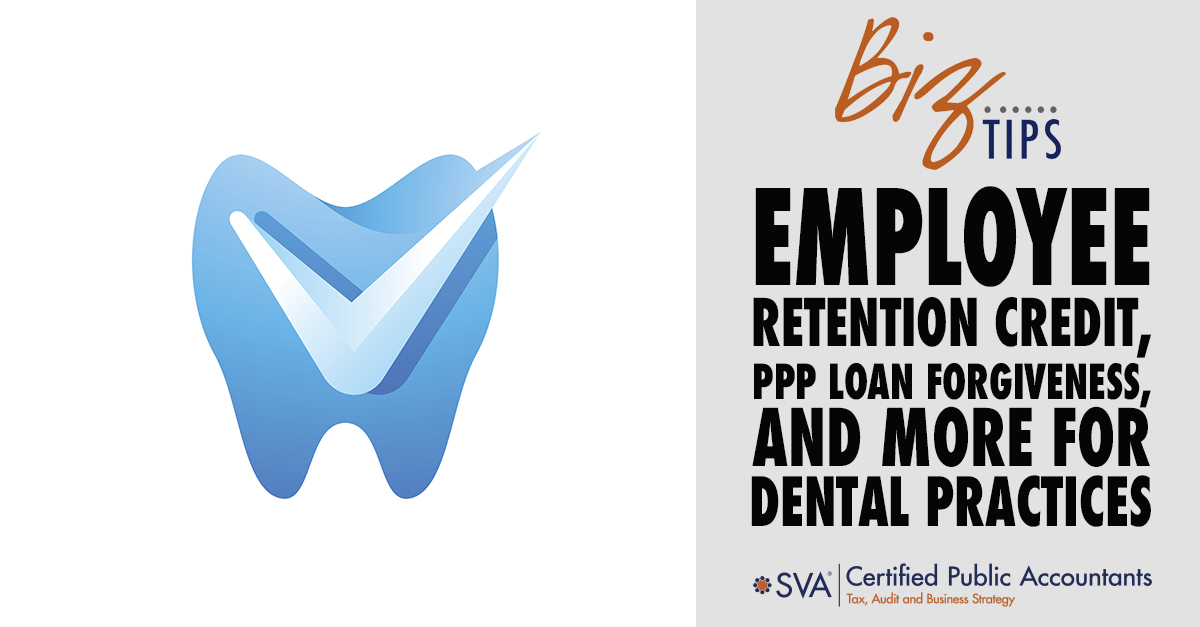

Published on: Nov 03, 2021 by Joel Rechlicz, EA
Updated on: October 16, 2025
Staying current on all the information and guidelines of government stimulus programs can be challenging for dental practice owners. From the Paycheck Protection Program to the Employee Retention Credit to the Provider Relief Funds, there are a number of essential programs dental practices can take advantage of.
To ensure your practice survives and thrives as we head toward year-end, it’s important you maximize all the credits, deductions, and funding available.
Over the past year, a lot of information has been disseminated concerning the Paycheck Protection Program (PPP). If your practice still needs to file for forgiveness, here are some important points to remember:
The Employee Retention Credit (ERC) is a valuable tax break that was extended and modified by the American Rescue Plan Act (ARPA). Congress enacted the ERC to encourage employers to hire and retain employees during the pandemic.
The ERC is a refundable tax credit against certain employee wages and employment taxes if you had a government shutdown or a decline in receipts in 2021 or 2020 when compared to the same quarter in 2019. Eligible wages depend on the number of full-time employees (FTEs) but owner and related-party wages are not eligible for the credit. Eligible employers can claim the refundable ERC against applicable employment taxes equal to 70% of the qualified wages the practice pays.
Originally, a business that received a PPP loan was not eligible to receive the ERC. In January 2021, the IRS retroactively allowed employers who received the PPP loan to claim the ERC for qualifying wages that are not treated as payroll costs in obtaining PPP loan forgiveness.
To qualify for the Employee Retention Credit in 2020, a dental practice needed a 50% decline in gross receipts during any quarter in 2020 compared to that same quarter in 2019. A practice could also qualify if they experienced a full or partial government shutdown (the Wisconsin Dental Association’s (WDA) recommendation does not qualify for this observed shutdown).
In 2021, a practice needed a 20% decline in gross receipts during any quarter in 2021 relative to that same quarter in 2019. Again, a practice could also qualify if they experienced a full or partial government shutdown.
The eligible wages that qualify for the Employee Retention Credit are dependent on the number of full-time employees in the dental practice.
*Between 2020 and 2021, the full-time equivalent increased from 100 to 500 employees.
When calculating your dental practice’s gross receipts, you need to show a 50% decline in a 2020 quarter when compared to the same quarter in 2019 (80% for 2021) to qualify for the ERC. If your practice does have a qualifying quarter, you must then determine if the following quarter’s gross receipts are less than 80%, when compared to the same quarter in 2019.
Example #1:
| RECEIPTS | ||||
| Year | Q1 | Q2 | Q3 | Q4 |
| 2020 | 100,000 | 190,000 | 230,000 | 250,000 |
| 2019 | 210,000 | 230,000 | 250,000 | 250,000 |
| 48% | 83% | 92% | 100% | |
When comparing 2020 to 2019 receipts, the first quarter was at 48% which qualified this practice. Then in the second quarter, the practice was at 83% which was above the 80% threshold. So in this example, the practice only had one qualifying quarter but the employer is entitled to the credit in quarter one and quarter two.
Example #2:
| RECEIPTS | ||||
| Year | Q1 | Q2 | Q3 | Q4 |
| 2020 | 100,000 | 180,000 | 230,000 | 250,000 |
| 2019 | 210,000 | 230,000 | 250,000 | 250,000 |
| 48% | 78% | 92% | 100% | |
In this example, the receipts were not at the 80% threshold in the second quarter so they would qualify in the first quarter and in the second quarter. The practice would then be entitled to the credit in the first, second, and third quarters.
How much credit can a dental practice actually receive?
In 2020, the credit is capped at $5,000 per year, per employee (this is a 50% tax credit up to $10,000 of wages). In 2021, it is $7,000 per quarter, per employee credit (this is a 70% tax credit up to $10,000 of wages). It is a quarter maximum, so you could feasibly save $28,000 per employee, per year if you had 80% or less in receipts when comparing each quarter with the corresponding quarter in 2019.
A practice cannot use the same wages for the PPP and the ERC. For the PPP, you must use at least 60% or more for wages, but you could use up to 40% for expenses such as employer portion of health insurance benefits, mortgage interest, rent, utilities, workforce training, and COVID-related expenses relating to supplies, equipment, and technology (e.g., sanitizers, air purification systems, HVAC systems, etc.).
It’s important to note that the PPP loan is based on 2.5 months of payroll wages and the forgiveness period is based on 5.5 months (24 weeks). So if you do qualify for the ERC, you should have plenty of wages available for the PPP as well as the ERC.
Before a dental practice even applies for PPP loan forgiveness, they first need to determine if they qualify for the ERC.
To really optimize the PPP and ERC, you want to make sure you qualify or might qualify, in any quarters in either 2020 or 2021, when compared to the same quarter in 2019. There’s another opportunity to qualify if the practice was fully or partially shut down due to a government order. However, in terms of government shutdown orders, it’s a pretty difficult path for most practices to get to since they were still able to be open to seeing emergency cases during most of 2020. Practices need to rely more on the revenue reduction to try and qualify.
If a practice has the second draw PPP loan, all expenses need to be considered during the covered period to make sure maximum PPP loan forgiveness is granted. So not just looking at payroll costs, but also looking at health insurance the practice is paying for its employees, COVID-related expenses (e.g., sanitizer, face shields, HVAC / air purification equipment, etc.), rent, mortgage interest, and utilities. The goal is to get 40% of the loan forgiven on these expenses so that the practice only has to use payroll costs for the other 60% of the PPP loan.
The crucial step in this entire plan is to make sure 100% of the PPP loan is forgiven. The income from this is tax-free income so there is no negative tax impact from those dollars. Not only should a practice make sure they get 100% of the PPP loan forgiven, but then they need to do everything they can to maximize the Employee Retention Credit on top of the PPP loan forgiveness.
The best-laid plans will use a combined ERC and PPP by using just enough wages to get full PPP forgiveness while keeping the balance of wages for the ERC.
The HHS Provider Relief Funds (PRF) is a federal program, implemented by the Department of Health and Human Services (HHS), to reimburse dental practices for healthcare-related expenses to either prevent, prepare for, or respond to COVID-19. The funds can also be used to reimburse the practice for any lost revenues that were attributable to COVID-19. This program is very similar to the Employee Retention Credit and PPP loans where the revenue in the practice is compared by quarter for 2019 and 2020 to determine if there was any decrease in any of those quarters.
With the Provider Relief Funds, there is potentially a reporting requirement with HHS if a practice had any one payment, or any multiple payments, that totaled more than $10,000 in aggregate. If so, the practice is going to have to do some reporting back to HHS about how they used those dollars in the practice. The reporting guidelines are as follows:
All of the reporting for these funds is done online through a portal with HHS.
To aid dental practices with further relief, there are two newer programs that are part of the HHS Provider Relief Funds. On September 29, 2021, healthcare providers (including dentists) are able to apply for $25.5 billion in relief funds through the Phase 4 General Distribution and the American Rescue Plan (ARP) Rural.
The Phase 4 program will distribute $17 billion based on providers’ lost revenues and changes in operating expenses from July 1, 2020 to March 31, 2021. Funds will be distributed in two ways:
This program will allocate $8.5 billion based on the amount of services providers furnish to Medicaid, CHIP, and Medicare beneficiaries living in the Federal Office of Rural Health Policy (FORHP)-defined rural areas.
Providers who serve Medicaid, CHIP, and Medicare patients who live in rural communities are eligible for the ARP Rural payments. HHS will price Medicaid and CHIP claims data at Medicare rates, with some limited exceptions for some services provided predominantly in Medicaid and CHIP.
Providers who serve any patients living in Federal Office of Rural Health Policy-defined rural areas with Medicaid, CHIP, or Medicare coverage, and who otherwise meet the eligibility criteria, will receive a minimum payment.
Understanding the many relief programs for dental practices, and the related qualifying and reporting rules, can be complex and confusing. It’s important to have a conversation with your CPA to make sure you are maximizing every opportunity.
If you have questions or need guidance, contact SVA today.
© 2021 SVA Certified Public Accountants
Share this post:

Joel is a Principal at SVA Certified Public Accountants with expertise in the healthcare, dental, and veterinary industries. He is involved with financial statements, benchmarking, payroll tax reporting and compliance, 1099s, personal property, and individual and business tax returns.
Get Weekly Biz Tips Delivered Straight to Your Inbox!
Services
Madison, WI
1221 John Q Hammons Dr, Suite 100
Madison, WI 53717
(608) 831-8181
Milwaukee, WI
18650 W. Corporate Drive, Suite 200
Brookfield, WI 53045
(262) 641-6888
Colorado Springs, CO
10855 Hidden Pool Heights, Suite 340
Colorado Springs, CO 80908
(719) 413-5551

Are you in the know on the latest business trends, tips, strategies, and tax implications? SVA’s Biz Tips are quick reads on timely information sent to you as soon as they are published.
Copyright © 2025 SVA Certified Public Accountants | Privacy Policy | Cookie Policy | CCPA